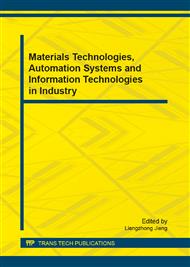[1]
H. Li, R. Shen and Y. Zhang. The dynamic yield model of crop water production function—the preliminary study on Feddes Model [J]. Guangai Paishui Vol. 4 (1997), pp.1-5 (in Chinese).
Google Scholar
[2]
E. Kunzova and M. Hejcman. Yield development of winter wheat over 50 years of FYM, N, P and K fertilizer application on black earth soil in the Czech Republic. Field Crops Research Vol. 111 (2009), pp.226-234.
DOI: 10.1016/j.fcr.2008.12.008
Google Scholar
[3]
H. Zhao, T. Zhang and R. Zhou. Soil environment and productivity formation process of corn in five types of farmland of Horqin sandy land. Acta Pedologica Sinica Vol. 40(2) (2003), pp.194-199 (in Chinese).
Google Scholar
[4]
L. Ma, L. Wang, F. Li, C. Liu and J. Li. The influence of spring wheat with insufficient irrigation at new irrigated region in Ningxia[J]. Chinese Journal of Agrometeorology Vol. 21(3) (2000), pp.39-41 (in Chinese).
Google Scholar
[5]
M. Heshmati, A. Arifin, J. Shamshuddin and N. M. Majid. Predicting N, P, K and organic carbon depletion in soils using MPSIAC model at the Merek catchment, Iran. Geoderma Vol. 175-176 (2012), pp.64-77.
DOI: 10.1016/j.geoderma.2011.12.028
Google Scholar
[6]
Q. Wu, L. Chao and G. Zhao. The fuzzy assessment of sustainable agricultural development potential of the soil and water resource in Inner Mongolia[J]. Research of Soil and Water Conservation Vol. 15(3) (2008), pp.141-145 (in Chinese).
Google Scholar
[7]
P. Su, M. Du, A. Zhao and X. Zhang. Study on water requirement law of some crops and different planting model in oasis[J]. Agricultural Research in the Arid Areas Vol. 20(2) (2002), p.79-85 (in Chinese).
Google Scholar
[8]
R. Shi. Agricultural chemistry analyses of soils, 2nd ed. China Agricultural Press, Beijing, China (1988), pp.37-39 (in Chinese).
Google Scholar
[9]
S. R. Olsen, C. V. Cole, F. S. Watanable and L. A. Dean. Estimation of available phosphorous in soils by extraction with sodium bicarbonate. USDA Circ., U.S. Government Printing Office, Washington, DC (1954). p.939.
Google Scholar
[10]
J. M. Bremner and C. S. Mulvaney. Salicylic acid-thiosulfate modification of Kjeldahl method to include nitrate and nitrite. In: A. L. Page et al. (eds. ), Methods of Soil analysis, Part 2, 2nd ed, Agronomy 9, American society of Agronomy, Madison, WI (1982).
Google Scholar
[11]
S. R. Olsen and L. E. Sommers. Phosphorous. In: A.L. Page et al. (eds), Methods of soil analysis, Part 2, 2nd ed, Agronomy 9, American Society of Agronomy, Madison, WI (1982), pp.403-429.
Google Scholar
[12]
P. Chen. Conventional analysis method of soil agricultural chemistry [M]. Science Press, Beijing, (1983) (in Chinese).
Google Scholar
[13]
X. Lv, Y. Lu and R. Wang. Prelimilary studies on the integrated evaluation of soil nutrient fertility. Journal of Zhejiang University (Agric. & Life Sci. ) Vol. 25(4)(1999), pp.378-382 (in Chinese).
Google Scholar


